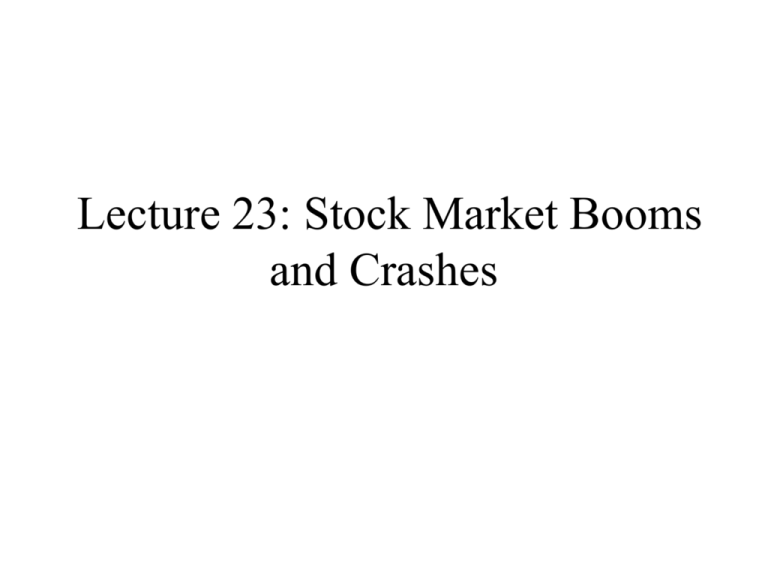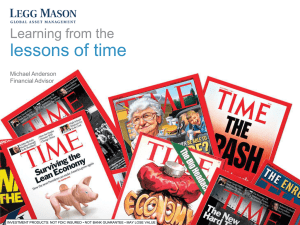Irrational Exuberance
advertisement

Lecture 23: Stock Market Booms and Crashes Brief History of Booms and Crashes • For hundreds of years, speculative markets have undergone dramatic ups and downs, that appear irrational to many observers • Tulipmania, 1630s, Holland • Mississippi Scheme, 1720, France, John Law’s Mississippi Company had monopoly of trading for province of Louisiana. • South Sea Bubble 1720, England, South Sea Company had British monopoly on trade in South Seas Up-Crashes • Popular view that markets rise slowly and crash suddenly is overblown • January 3, 2001, Nasdaq went up 14% in one day, following rate cut • October 6, 1931, Dow went up 14.87% following President Hoover’s plan for economic recovery • Biggest 1-day crash October 19, 1987 Dow fell 22.6%, much larger than largest upcrash, but also twice as big as next largest downcrash Mackay vs. Garber • David Mackay, Extraordinary Popular Delusions and the Madness of Crowds, 1841, popularized these stories of bubbles • Peter Garber, Famous First Bubbles, 2000, said Mackay’s bubble stories were not inconsistent with perfect investor rationality Efficient Markets Hypothesis • Stock market level is always unforecastable, not inconsistent with crashes • Volatility may be forecastable, and in that sense crashes may be forecastable • Efficient markets hypothesis denies the Mackay theory that something fundamentally irrational is going on in booms and crashes • Fundamental disagreement in the finance profession about how to model markets Irrational Exuberance • • • • • • The Stock Market in Historical Perspective Part 1: Structural Factors Part 2: Cultural Factors Part 3: Psychological Factors Part 4: Attempts to Rationalize Exuberance Part 5: Tension between Efficient Markets Theory and Financial Innovation • The Next Few Decades The Stock Market in Historical Perspective S&P500 Jan 1871-Feb 2004 S&P 500 Price/(10-Year Earnings) Jan 1881-Feb 2004 Nikkei Index, Jan 1984-Feb 2004 45000 40000 35000 Nikkei Index 30000 25000 20000 15000 10000 5000 0 1980 1985 1990 1995 Year 2000 2005 2010 Germany Dax Nov. 1990 – Nov. 2003 9000 8000 7000 6000 5000 4000 3000 2000 1000 0 1990 1992 1994 1996 1998 2000 2002 2004 2006 UK FTSE 100 April 1984-Nov. 2003 8000 7000 6000 5000 4000 3000 2000 1000 0 1980 1985 1990 1995 2000 2005 France CAC 40 March 1990- Nov. 2003 7000 6000 5000 4000 3000 2000 1000 0 1988 1990 1992 1994 1996 1998 2000 2002 2004 2006 P/E Predicts 10-Year Returns Price Earnings Ratio Predicting Subsequent Ten-Year Real Returns Annual January Data, 1881-1990 (1891-2000 returns) S&P Ten-Year Subsequent Real Return 20 1919 15 1990 1982 10 1935 1899 5 1914 1929 0 1911 1965 -5 0 5 10 15 20 25 30 35 S&P Real Price / 10-Year Average Real Earnings 40 45 50 One-Year Confidence, USA Valuation Confidence, USA Faith in the Stock Market “The stock market is the best investment for long-term holders, who can just buy and hold through the ups and downs of the market.” 1996 1999 2000 2001-2 2002 2003 1. Strongly agree 69% 76% 63% 60% 46% 39% 2. Agree somewhat 25% 20% 34% 31% 40% 44% 3. Neutral 2% 2% 2% 3% 5% 8% 4. Disagree somewhat 2% 1% 1% 5% 8% 5% 5. Strongly disagree 1% 1% 0% 1% 2% 5% (Individual investors) • • • • • Historical Intervals between Normal Years (Excluding War, Recession) 1. 1871-1891 2. 1891-1913 3. 1913-1928 4. 1928-1950 5. 1950-1964 • • • • 6. 1964-1972 7. 1972-1979 8. 1979-1988 9. 1988-1996 Earnings, Productivity & Value Grow th over Historical Intervals 15 Grow th Rate (Annual %) 10 Real S&P Earnings 5 Productivity (Gordon Multifactor) 0 1 2 3 4 5 6 -5 -10 Interval Num ber 7 8 9 Real Cumulated S&P Value (w ith Dividends) Part 1: Structural Factors • Precipitating Factors: the Internet, the Baby Boom, and other events • Amplification Mechanisms: Naturally Occurring Ponzi Schemes Precipitating Factors • The World Wide Web • Triumphalism • Culture Favoring Business Success • Republican Congress & Capital Gains Taxes • Baby Boom • Media Expansion • • • • • Optimistic Analysts 401(k) Plans Rise of Mutual Funds Decline of Inflation Expanding Volume of Trade • Rise of Gambling Opportunities Variations in Factors Since March 2000 • WWW: Dot-com bust weakened faith. Productivity numbers for 1990s revised down, strong productivity growth since then • Triumphalism: China 9% growth in 2003 • Republican Congress: Republican James Jeffords defection to Independent May 2001, Democratic Senate 51-49, back to Republican senate 51-48 Nov. 2002 • Optimistic Analysts: All major Wall Street firms have announced new guidelines, HSBC abolishes “hold” recommendation, “equal” buy and sell. Post-Enron reforms may reduce incentives for optimistic bias. • Mutual funds: net new flow into stock mutual funds was $32 billion in 2001, compared to $309 billion in 2000, then back up to $69 billion in year ending February 2004 (all in first two months of 2004). Amplification Mechanisms • • • • Price-to-price Price-to-gdp-to-price Price-to-earnings-to-price Naturally Occurring Ponzi Scheme Amplification Through Expectations • PaineWebber/Gallup Poll: Expect 15.0% return on stock market over next 12 months in 1999. • My polls of individual investors: Expect 4.6% increase in Dow over next twelve months in 1999. Part 2: Cultural Factors • The News Media • New Era Economic Thinking • New Eras and Bubbles around the World Largest Recent One-Year Real Stock Price Changes • • • • • • • • Philippines 683.4% Dec. 1985-Dec. 1986 Taiwan 400.1% Oct. 1986-Oct. 1987 Venezuela 384.6% Jan. 1990-Jan.1991 Peru 360.9% Aug. 1992-Aug. 1993 Colombia 271.3% Jan 1991-Jan. 1992 Jamaica 224.5% Apr. 1992-Apr. 1993 Chile 199.8% Jan. 1979-Jan. 1980 Italy 166.4% May 1985-May 1986 Part 3: Psychological Factors • Psychological Anchors for the Market • Herd Behavior and Epidemics Prominent Psychological Theories • Anchors: Kahneman & Tversky Wheel of Fortune experiment • Overconfidence • Attention Anomalies Part 4: Attempts to Rationalize Exuberance • Efficient Markets, Random Walks, and Bubbles • Investors’ Learning — and Unlearning Price and Dividend Present Value 1600 1400 Real S&P Composite Index 1200 1000 800 600 400 Dividend Present Value 200 0 1860 1880 1900 1920 1940 1960 1980 2000 2020 Irving Fisher 1929 “It was only as the public came to realize, largely through the writing of Edgar Lawrence Smith, that stocks were to be preferred to bonds during a period of dollar depreciation, that the bull market began in good earnest to cause a proper valuation of common shares.” The Crash of 1929 • Complete absence of news • Smoot-Hawley Tariff not news • Sequence of events led to bottom 1932 The Crash of 1987 • Lawrence Harris, “The October 1987 S&P Stock Futures Basis • Futures price too low to be explained by nontrading lags in index Questionnaire Survey Oct 1987 • Average time individuals heard of the crash, 1:56pm EDT (10:56am PDT) October 19, 1987 • Average individual spoke to 7.4 other individuals about stock market that day • 81.6% of individuals heard about the crash before 5pm Ranking of Importance of News Stories 1. The 200-point drop of the Dow that morning 5.14 (on 1-7 scale) 2. Drop in Dow October 14-16 4.54 3. Treasury bond yields hit 10.5% 4.27 4. Trade deficit figures 4.21 5. Chemical bank raises prime rate 4.14 6. Baker suggesting dollar should fall 4.04 Psychology or Fundamentals? • Which of the following better describes your theory about the declines: a theory about investor psychology or a theory about fundamentals such as profits or dividends – Psychology 67.5% individuals, 64.0% institutional 1987: Investors Thought They Knew What Will Happen • “Did you think at any point on October 19, 1987 that you had a pretty good idea when a rebound was to occur?” -Individuals 29.2% yes, Institutions 28.0% yes If Yes, why? -gut feeling, intuition, market psychology, common sense, story telling The Nikkei Crash after 1989 • • • • • Nikkei peaked last day of 1989, nearly 40,000 Has remained below half that since High expectations for Japanese economy in 1980s Bubble Economics, Yukio Noguchi 1992 Many reasons for slow growth in Japanese economy since then, but tend to be related to bubble situation in 1980s • Nikkei 1989 a model for Dow 2000? Samuelson’s Dictum • Market Efficiency Theory Has Some Merit • Samuelson’s Dictum: Some evidence of micro efficiency and macro inefficiency Present Value of Dividend Changes Plotted Against D/P Ratio 1.5 dividend growth 1 0.5 0 -0.5 0 0.1 0.2 0.3 D/P ratio 0.4 0.5 Part 5: Tension Between Efficient Markets Theory and Behavioral Finance • Aggregate markets are not very efficient • Investors make many systematic mistakes • And yet, financial markets matter very much for economic success • All successful economies have sophisticated financial institutions Concluding Thoughts The Next Few Decades • The most exciting prospect: the developing world catches up • Financial Markets will be everywhere, dominating people’s lives • Financial booms and crashes will be even bigger than before • Worse things have happened in history! Dramatic Change in Finance, our Economy • Experience of last century suggests dramatic changes in the next • Information technology unleashes a cascade of other changes in the economy • Other technology transforms the world economy, creating opportunities and challenges Risk and Chance over Careers • Century-long personal outlook • Reflections on upheavals in last century • Stock market risk is compounded by individual career risk • Illusion of invulnerability Ecclesiastes IX 11 “I returned and saw under the sun that the race is not to the swift, nor the battle to the strong, neither yet bread to the wise, nor yet riches to men of understanding, nor yet favour to men of skill; but time and chance happeneth to them all.” Career Risks • Joshua Angrist, Analysis of draft lottery, 1969. Low RSN lowered income decade later by 15% • Over half of the cross-individual variance in incomes cannot be explained either by age, schooling, experience, parents income, parents occupation, or transitory component [Bowles et al. JEL Dec. 2001] A Risky World • Media focus on success • Longer-run perspective: people in positions come and go by chance • Careers and economic success “come together” by the strangest coincidences Human Capital, Positioning, and Meaning • Maintain an orientation towards history in the making, rather than to one’s own point in the life cycle • Maintain human capital, strategically oriented • Maintain humanity in an unforgiving business world Don’t Sell your Textbook




